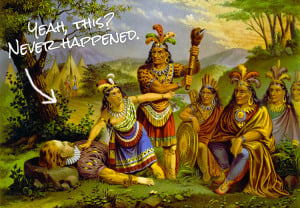http://nativewarriors.net/8-things-the-history-books-dont-tell-us-about-native-people.html



Originally published on Indian Country Today Media Network
Do history books written by white folks tell the truth about Natives in the US? We think not.
Here are just some of the things they fail to mention.
1. Columbus NEVER landed in the Upper 48—Ever
Every year across the country countless elementary school students recite: “In 1492, Columbus sailed the ocean blue,” and many perform a play about him discovering Indians in America.
The thing is, Columbus never landed in what would become the United States. He actually landed in the Caribbean.
2. Basically Everything About Pocahontas
Pocahontas was about 8 years old when John Smith arrived, and was later married to another young Indian warrior. She also had a child that was given away before she was kidnapped by the English and then married to John Rolfe.
Sorry Disney, and many incorrectly written textbooks, Pocahontas never fell in love with John Smith.
According to tribal oral histories as well as The True Story of Pocahontas by members of the Mattaponi Tribe, Pocahontas’ original young Native husband was killed and Pocahontas’ newborn was given to relatives before she was forced into captivity at about 15 or 16 years of age.
3. The First Thanksgiving
Thanksgiving was named after an entire tribe’s massacre — not a peaceful meal between pilgrims and Indians.
In 1621, Wampanoag Indians investigated gun and cannon fire at a Pilgrim settlement to see them celebrating a successful harvest. The Indians — all male warriors, were fed as a gesture of peace. The act was not repeated annually.
In 1636, when a murdered man was discovered in a boat in Plymouth, English Major John Mason collected his soldiers and killed and burned down the wigwams of all the neighboring Pequot Indians who were blamed for the murder.
The following day, Plymouth Governor William Bradford applauded the massacre of the 400 Indians, including the women and children. The Governor of the Massachusetts Bay Colony, William Newell, proclaimed: “From that day forth, shall be a day of celebration and thanks giving for subduing the Pequots.”
For the next 100 years, every Thanksgiving Day ordained by a governor was in honor of the bloody victory, thanking God that the battle had been won.
4. What is a Redskin?
“It was only five generations ago that a white man could get money for one of my grandfather’s scalps,” wrote 1491’s comedian Dallas Goldtooth on Facebook. “At this time… it was ‘Redskin’ that was used to describe us.”
In his post, Goldtooth also included a newspaper clipping from after the U.S. Dakota Wars of 1862: “The state reward for dead Indians has been increased to $200 for every red-skin sent to Purgatory.”

5. Lincoln Ordered a Mass Execution
In the fall of 1862, Native tribes in Minnesota waged war on white settlers out of frustration from starvation, mistreatment and harsh conditions.
After soldiers captured over 300 Indians, President Abraham Lincoln approved the largest mass execution in U.S. history on 38 Dakota men.
On the day of their hanging, an estimated 4,000 spectators watched them hung. Their bodies were later taken and used as medical cadavers.
6. Hitler Studied Reservations
There are many accounts of the Nazis and Hitler studying Indian reservations for guidance in planning encampments for the Jewish. Perhaps Lia Mandelbaum says it best in her article found in the Jewish Journal entitled “Hitler’s Inspiration and Guide: The Native American Holocaust.”
From 1863 to 1868, the U.S. military persecuted and imprisoned 9,500 Navajo (the Diné) and 500 Mescalero Apache (the N’de). Living under armed guards, in holes in the ground, with extremely scarce rations, it is no wonder that more than 3,500 Navajo and Mescalero Apache men, women, and children died while in the concentration camp.
During the film I learned about something that shook me to my core that I had not heard before. I learned that the genocidal mentality and actions of the U.S. policy makers would find similar expression years later when the Nazis, under Hitler, studied the plans of Bosque Redondo to design the concentration camps for Jews.
7. There Are 566 Federally Recognized Tribes in the U.S.
When I was a student in high school, I learned that George Washington saw Indians in Virginia and possibly heard once or twice about the Cherokee Trail of Tears.
But in 18 years of public school (and a few of private Catholic School) — not once did I learn about the multitude of tribes, languages or cultures involved in this country.
NOT ONCE.
8. Unwritten History of African Americans and Natives
Dr. Arica L. Coleman is the assistant professor of Black American Studies at the University of Delaware. She is African American and Native American (Rappahannock).
Due to her ancestry, she has done a lot of thinking about the relations and interactions of Blacks, Indians and whites on the East Coast, primarily in Virginia.
According to Coleman, who turned her Ph.D. dissertation into a book titled That the Blood Stay Pure, there was Indian slavery in Virginia.
“The first slaves in the Americas were Native American and this business that the Native Americans died off as a result of disease and war [is inaccurate]—those were not the only reasons for their demise, there was the Indian slave trade, which is something we do not discuss a lot,” she writes.
Coleman also writes about Walter Plecker, a man who once worked as the first registrar of Virginia’s Bureau of Vital Records. A man who literally changed races in Virginia’s birth records. His actions have been coined as “pencil genocide.”
Similarly, William Loren Katz, the author of Black Indians has written how entire cities of blacks and Indians came together as a strong force against European settlers including huge factions of black Seminoles who created nearly impenetrable forces against those soldiers foolish enough to try and break into Florida, and suffered miserable defeats over several years.




